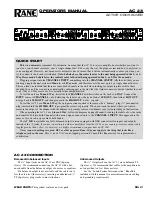
Manual-12
until the display shows +3 dB (red). The amount of
displacement correction available from the Delay
depends on the actual crossover frequency: the higher
the frequency, the less amount of correction capability.
If the drivers are built into a single cabinet and/or it is
impossible to change relative positions, then you will
have to obtain additional external delay to achieve
proper phase alignment.
iv. If turning the MID DELAY control up makes the
display reading decrease instead of increase, this means
that the high driver is actually in front of the mid driver;
adding delay to the mid driver then only worsens the
situation. There are a couple of ways to deal with this:
a. Try to move the high driver back as far as possible
without losing stability in balancing the speaker stack.
You may want to raise it up as well to restore disper-
sion close to the stack. If you cannot move the high
driver, then you will have to obtain an additional
delay source to align the high and mid drivers. The
built-in delay system in the AC 23 is designed to
accommodate the majority of common speaker
configurations; if you encounter confusion or diffi-
culty with your particular system, it is best to consult
your dealer or the Rane factory for assistance.
b. If this decrease in the display due to the DELAY
control occurs at a low frequency crossover point
below about 150 Hz, set the DELAY control to
minimum and leave it there. Frequencies below 150
Hz are actually omnidirectional, so that phase
misalignment is virtually inaudible below this point.
Subwoofers will often possess long folded or straight
horns, resulting in the diaphragm being well behind
the rest of the stack. Most authorities agree that phase
alignment of subwoofers is unnecessary. Otherwise
you will have to obtain additional delay equipment to
align these to the rest of the system.
6. Lower the microphone until it is vertically midway
between the mid and low drivers. Repeat steps 2 through 5,
using the crossover LEVEL control, MUTE switch and
next DELAY control. You may start each series of steps 2
through 5 at a different volume as necessary—but once the
Levels are set in step 3 do not alter these until step 5 is
completed. Once all of the crossover DELAY controls are
set, then adjust the output LEVEL controls as outlined on
page Manual-15.
Time Delay Adjustment Using
SPL Meter & Tone Generator
Now that good quality realtime analyzers are becoming
more affordable and easier to use, there are few reasons why
one of these should not be regularly used in any sound
system. If an analyzer is simply not available or for some
reason inappropriate, an accurate delay setting can be
obtained by using a straightforward SPL meter (obtainable at
most local electronics and some hi-fi stores) and some kind of
variable tone generator.
In order to exclude the effect of room acoustics and
imperfect driver response, only the crossover frequencies are
to be emitted (one at a time) by the tone generator. First the
highest crossover frequency is run through the crossover and
each of the two speakers sharing the crossover point is set
separately to an arbitrary 0 dB level on the SPL meter. When
both drivers emit the crossover tone simultaneously, the
combined response should read +3 dB higher on the meter. If
the drivers are not phase aligned, some cancellation will occur
on-axis, resulting in a combined response less than +3 dB.
Turning the delay control up causes the lower frequency
driver to electronically move backward until the SPL meter
reads +3 dB; then the two drivers are electronically aligned
and the on-axis cancellation is eliminated. This procedure is
then repeated for the next lower crossover point(s).
STEP BY STEP PROCEDURE
A 3-Way mode consisting of high, mid and low drivers is
used here as an example. For other configurations, use the
same procedure starting with the highest crossover point and
repeating steps 2 through 5 for each lower crossover point.
1. Set the tone generator to the highest crossover frequency
and plug it into the INPUT of the crossover. Turn all
crossover LEVEL controls fully down.
2. Position the SPL meter (microphone) about 15 feet in front
of the speakers and at a height about midway between the
high and mid drivers. It is very important that the meter
remain in exactly the same position throughout the test, so
affix it to a mic stand, small tree or other stable object. Set
the switches on the SPL meter to “C-weighting”, “Slow” if
available. Be sure to minimize background noise (air
conditioners, fans, traffic, wild animals, etc.) as these will
effect the meter reading.
3. Slowly turn up both the crossover MASTER LEVEL
control and the MID LEVEL control until the tone is heard
through the mid driver. Adjust the SPL meter control and/
or the crossover LEVEL controls until you obtain a 0 dB
reading on the meter. Verify that no sound is coming from
any other speakers except the mid driver.






















